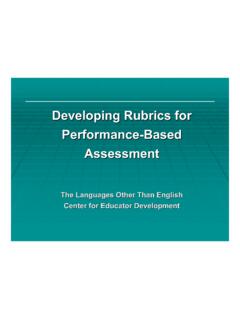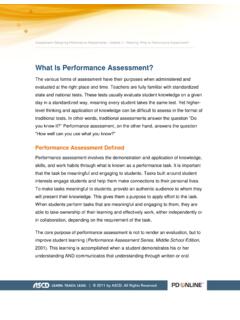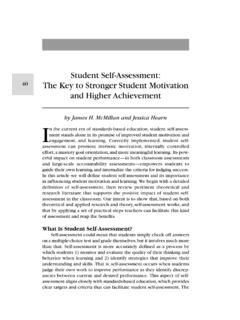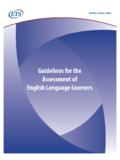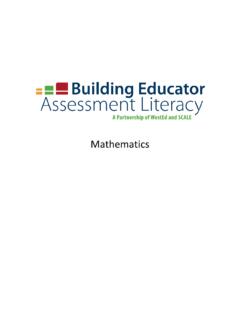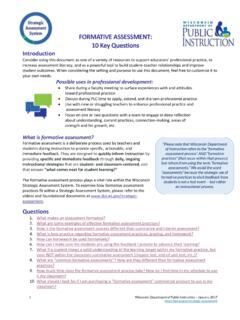Transcription of Reflective Assessment: Including Students in the ...
1 Forum on Public Policy 1 Reflective assessment : Including Students in the assessment Process John B. Bond, Assistant Superintendent, Northshore School District Abstract Over the last decade alternative assessment strategies have become an important part of the debate regarding the reform and restructuring of American education. The purpose of assessment should be to improve student learning, which means it should be integral to the teaching and learning process. For this to occur, a seamlessness needs to exist between teaching, learning, and assessment through which Students are empowered to take increased responsibility for their learning. Reflective assessment grows out of strong theoretical roots Including ancient Greek thought, the philosophy of John Dewey, and cognitive constructivist learning theories.
2 Reflective assessment is a formative process through which Students can experience assessment as a part of learning, rather than as a separate evaluative process. Reflective assessment : Including Students in the assessment Process Over the last decade alternative assessment strategies have become an important part of the debate regarding the reform and restructuring of American education. In contrast to the more familiar focus upon standardized testing, this discussion and inquiry has expanded to include the informal, ongoing, formative assessments that occur within the walls of the classroom. According to Wiliam and Thompson (2008, 59) three functions are served by educational assessments-- supporting learning (formative), certifying the achievements or potential of individuals (summative), and evaluating the quality of educational institutions or programs (evaluative).
3 It is the first function, supporting learning or formative assessment , that deserves heightened attention by the educational community. Particularly, it is how such formative assessment is seamlessly integrated into the teaching and learning experience that has sparked increased attention to this area (Ellis 2001; Wragg 1997). The aim of this paper is to examine the role of student reflection in a seamless teaching, learning, and assessment process. The purpose of assessment has become confused with the overemphasis that is placed on standardized tests (Stiggins 1997). Rather than integral to teaching and learning, assessment is often viewed as a separate process (Herman, Aschbacher, and Winters 1992). Such significant matters as problem solving and complex thinking are often neglected in favor of specific and routine skills that are learned out of context (Wiggins 1993).
4 A narrowing of the curriculum becomes a risk when teachers feel increased pressure to raise test scores (Wiliam and Thompson 2008, 59). Increased criticism of summative assessment points to negative impacts on student self-esteem and reduced self- assessment , both of which are linked to how Students learn (Black and Wiliam 1998; Povey and Angier 2007). Wiliam (2007) emphasizes that assessment Forum on Public Policy 2 information helps learning when used by teachers and Students to modify teaching and learning activities. In their recent writing on integrating assessment practices, Wiliam and Thompson (2008, 64) further articulate this view: The big idea is that evidence about student learning is used to adjust instruction to better meet student needs in other words, that teaching is adaptive to the student's learning needs.
5 Unfortunately, such seamlessness between teaching, learning, and assessment that should occur naturally in the classroom (Ellis 2001; Perrone 1994, 11-13; Simmons 1994, 22-23; Wragg 1997) is not at the center of the learning process. Michael Scriven is credited with first using the term formative (Scriven 1967) to describe evaluation that is intended to assess the effectiveness of new curricula (Bloom, Hastings, and Maudaus 1971; Brookhart 2001, 153-169). Still writing in the field twenty-five years later, Scriven (1991) expanded his definition of formative assessment to include .. evaluation designed, done, and delivered to someone who can make improvements. It is the someone who can make improvements Scriven refers to that is at the crux of the assessment dilemma.
6 When the student is included, along with the teacher, as someone who can make such improvements, the potential exists to transform the classroom experience. Students need to become the ultimate users of classroom assessment information that is elicited to improve learning (Black and Wiliam 1998, 139-148; Stiggins 1997). Of the three reasons offered by Ellis (2001, 38) for assessing teaching and learning to classify Students , to diagnose Students , and to encourage and support student learning it is the last one that captures the rationale for involving Students in the assessment process. Effective assessment practices offer Students an opportunity to reflect upon what they are learning (Earl and LeMahieu 1997). It is through this reflection that Students experience assessment as a part of learning, rather than as a separate evaluative process (Wiggins 1993; Earl and LeMahieu 1997, 149-167).
7 Rather than assessing a final product, it is ..supporting progress toward that that is most important (Guskey 2005, 32). assessment should begin to answer two fundamental questions: How are we doing? and How can we do it better? (Herman et al. 1992). The we that Herman and colleagues refer to should be a partnership that includes the learner. Definitions reflection, metacognition, thinking about thinking Forum on Public Policy 3 Metacognition, or Reflective practice, is a concept of cognitive psychology which focuses on the active participation of the individual in his or her thinking process (Stewart and Landine 1995, 16-20). It involves thinking about thinking and emphasizes the individual s self-awareness of his or her thinking patterns, learning characteristics and techniques which aid both memory and comprehension (Schneider, Borkowski, Kurtz, and Kerwin 1986, 315-336).
8 Costa (2001) uses the terms metacognition and thinking about thinking interchangeably to mean the ability to know what we know and what we don t know. Metacognition refers to self-knowledge about cognitive states and processes (Flavell 1971, 272-278). Others define reflection in similar terms as an important human activity in which people recapture their experience, think about it, mull it over, and evaluate it (Boud, Keogh, and Walker 1985). Costa and Kallick (2000, 27) provide further definition of terms in the following statement: Intelligent people plan for, reflect upon, and evaluate the quality of their own thinking skills and strategies. Metacognition means becoming increasingly aware of one s actions and the effect of those actions on others and on the.
9 Content vs. Thinking Conversation and debate continue among curriculum experts regarding the respective roles of content and reflection, but there appears to be agreement that both are essential ingredients in a student s education (Stiggins 1995, 238-245). Some educators feel that teaching content is overemphasized to the detriment of considering thinking as the core of the curriculum (Costa 2001). Costa (2001, 246) states that content, when judiciously selected for its rich contributions to thinking and learning, becomes the vehicle to carry the learning processes. The focus is on the learning from the objectives instead of learning of the objectives. Students need to know their learning targets in order to answer the fundamental question Where am I going?
10 On which all learners should reflect (Chappuis 2005, 40). Student Reflection vs. Teacher Feedback Sadler (1989, 119-144) distinguishes between feedback information that is provided by the teacher to the student and self monitoring information about performance from a student s own appraisal of their work. These contrasting uses of information about learning unveil the critical issue of who owns the information, the teacher or the student. Wilson (1986, 199) states that the purpose of informal Reflective activity is to both encourage student reflection and to provide feedback to the teacher about their teaching . Diagnostic information can inform both Forum on Public Policy 4 Students studying and teachers teaching (Brookhart 2001, 153-169).










